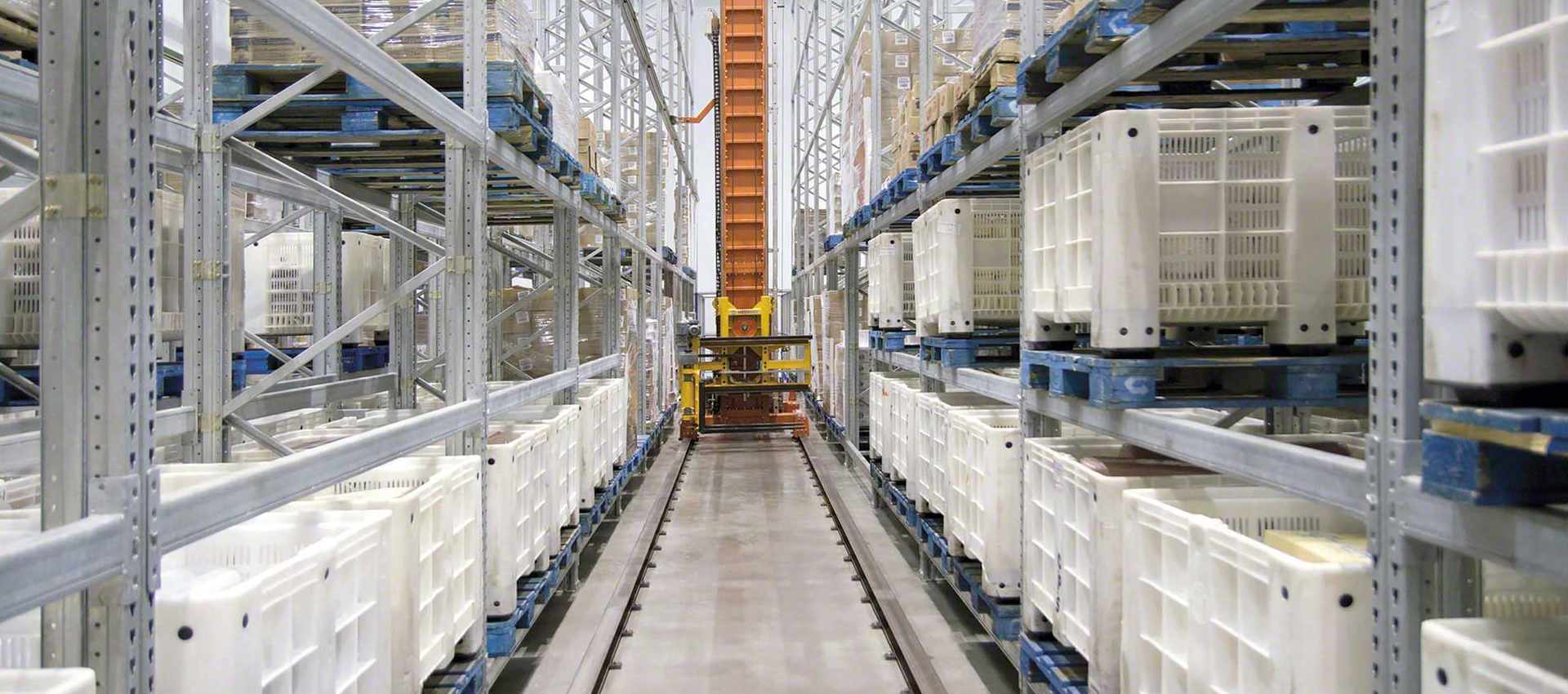Automated warehouse systems have revolutionised the way businesses store and retrieve products. One of the most effective forms of these systems is Automated Storage and Retrieval Systems (ASRS). ASRS has transformed warehouse management by offering increased storage capacity, improved efficiency, and reduced labour costs through automated storage systems.
Automated storage systems are a crucial part of modern warehouses’ storage and retrieval processes. These systems have become essential tools for businesses looking to optimise their warehouse management processes. This article will thoroughly discuss one of the most effective forms of automated warehouse systems – Automated Storage and Retrieval Systems (ASRS).
Overview of ASRS
Automated Storage and Retrieval Systems is an automated warehouse system that uses advanced technologies to store and retrieve products. ASRS comprises various technologies facilitating product storage and retrieval, including vertical lift modules (VLMs), automated storage systems, carousels, and shuttle systems.
VLMs are vertical storage systems that use a vertical lift to store and retrieve products. They are ideal for warehouses with limited floor space as they can utilise vertical space. AS/RS uses automated storage and retrieval cranes to transport and store products. Carousels use a rotating system to retrieve and store products. Shuttle systems use automated shuttles that move along a track to store and retrieve products.
ASRS offers several benefits to businesses, including increased storage capacity, improved efficiency, and reduced labour costs. Automated storage systems allow businesses to store more products in less space, thereby reducing the need for additional warehouse space. Additionally, ASRS is faster and more accurate than manual systems, thereby improving efficiency. Finally, ASRS reduces labour costs by minimising the need for manual labour.
How does ASRS work?
ASRS comprises three key components: automated material handling equipment, software systems, and storage and retrieval systems. Automated material handling equipment includes automated guided vehicles (AGVs), conveyor systems, and robotics. Software systems include warehouse management systems (WMS), warehouse control systems (WCS), and warehouse execution systems (WES).
The automated storage systems process flow begins with a product being scanned and entered into the system. The system then determines the product’s location and sends a command to the storage and retrieval system to retrieve the product. The storage and retrieval system retrieves and delivers the product to the automated material handling equipment. The automated material handling equipment then provides the product to the appropriate location.
AGVs are used to transport products within the warehouse. They are guided by a control system that tracks their movements. Conveyor systems are used to transport products between different areas of the warehouse. Robotics are used to automate tasks such as picking, packing, and labelling products.
WMS, WCS, and WES are software systems that manage warehouse operations. WMS manages the inventory, orders, and shipment of products. WCS controls the flow of products within the warehouse. WES integrates the functions of WMS and WCS to manage the entire warehouse operations.
Applications of ASRS
Here are some additional applications of ASRS:
Pharmaceuticals: Automated storage systems manage pharmaceutical inventory and ensure that medications are stored under optimal conditions, such as temperature-controlled environments.
Retail: Retailers use ASRS to store and manage products, allowing for quick and easy retrieval of items for customers.
E-commerce: ASRS is used in e-commerce fulfilment centres to store and manage products, allowing for fast and efficient order processing.
Automotive: Automated storage systems are used in automotive manufacturing plants to manage inventory and improve efficiency.
Chemicals: ASRS is used in chemical manufacturing facilities to manage inventory and ensure compliance with regulations for hazardous materials.
Food and Beverage: ASRS is used in food and beverage manufacturing and distribution centres to manage inventory and ensure compliance with regulations for food safety.
Healthcare: Hospitals and medical centres use ASRS to manage medical supplies and equipment, ensuring that critical items are readily available.
Overall, automated storage systems have various applications across various industries where efficient and accurate inventory management is critical to operations. By implementing ASRS, businesses can improve efficiency, reduce labour costs, and ensure compliance with regulations, ultimately improving their bottom line.
Factors to Consider When Implementing ASRS
When considering implementing an Automated Storage and Retrieval System (ASRS), businesses should take into account the following factors:
Warehouse design: The warehouse design should be optimised to accommodate the ASRS system. The design should consider the warehouse size, the height of the ceiling, and the location of the loading and unloading docks.
Type of ASRS system: Different types of Automated storage systems are available, and the right system should be chosen based on the products being stored, the warehouse size, and the throughput requirements. Businesses can choose from vertical lift modules (VLMs), automated storage and retrieval systems (AS/RS), carousels, or shuttle systems.
Cost: The cost of implementing ASRS can vary based on multiple factors, such as the type of system, the size of the warehouse, and the level of automation required. Businesses should consider the return on investment (ROI) of implementing ASRS.
Training and support: ASRS requires specialised skills and knowledge to operate and maintain the system. Businesses should ensure that employees are adequately trained to operate and maintain the system. Additionally, reliable support and maintenance services should be available to ensure the system’s smooth operation.
Safety: Safety is paramount in any warehouse environment. Businesses should ensure that ASRS systems are designed and installed with safety in mind, including safety sensors and other safety features.
Integration with existing systems: Integrating ASRS with existing warehouse systems can be challenging. Businesses should consider the compatibility of the ASRS system with existing warehouse management systems (WMS) and enterprise resource planning (ERP) systems.
Regulatory compliance: Businesses should ensure that Automated storage systems comply with relevant regulations, such as food safety regulations, fire safety regulations, and environmental regulations.
By considering these factors, businesses can ensure that they implement the right ASRS system that meets their needs and provides the expected benefits.
Conclusion
ASRS is a highly effective form of automated storage system that offers several benefits to businesses, including increased storage capacity, improved efficiency, and reduced labour costs. ASRS comprises a variety of technologies, including VLMs, AS/RS, carousels, and shuttle systems. Implementing automated storage systems requires careful planning and consideration of several factors, including warehouse design, cost, training, and support. Several businesses have implemented ASRS systems and have achieved significant benefits. The future of ASRS looks bright, with the system expected to become more advanced and efficient.

 David Copperfield Net Worth 2024: How Much is the Novel by Charles Dickens Worth?
David Copperfield Net Worth 2024: How Much is the Novel by Charles Dickens Worth? Noel Biderman Net Worth 2024: How Much is the Canadian Internet entrepreneur and business professional Worth?
Noel Biderman Net Worth 2024: How Much is the Canadian Internet entrepreneur and business professional Worth? Adam Selipsky Net Worth 2024: How Much is the CEO of Amazon Web Services, Inc. Worth?
Adam Selipsky Net Worth 2024: How Much is the CEO of Amazon Web Services, Inc. Worth? Ken Langone Net Worth 2024: How Much is the American Businessman Worth?
Ken Langone Net Worth 2024: How Much is the American Businessman Worth? Anthony Geisler, Xponential Fitness Founder and CEO Suspended “Indefinitely” Amid Fraud Allegations
Anthony Geisler, Xponential Fitness Founder and CEO Suspended “Indefinitely” Amid Fraud Allegations Navigating Forex Brokers: Choosing the Right Partner for Your Trading Journey
Navigating Forex Brokers: Choosing the Right Partner for Your Trading Journey Navigating the Complexities of MT4: A Comprehensive Guide for Beginners
Navigating the Complexities of MT4: A Comprehensive Guide for Beginners Melinda Gates Resigns As Co-Chair of Gates Foundation, Bill Gates Responds
Melinda Gates Resigns As Co-Chair of Gates Foundation, Bill Gates Responds